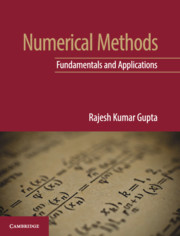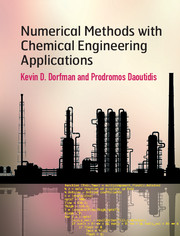Refine search
Actions for selected content:
1945 results in Engineering mathematics and programming

Numerical Methods
- Fundamentals and Applications
-
- Published online:
- 26 April 2019
- Print publication:
- 09 May 2019
-
- Textbook
- Export citation

Numerical Methods with Chemical Engineering Applications
-
- Published online:
- 09 August 2018
- Print publication:
- 11 January 2017
-
- Textbook
- Export citation

Linear Algebra
-
- Published online:
- 21 June 2018
- Print publication:
- 24 May 2018
-
- Textbook
- Export citation
Chapter 12 - Least squares
- from Part III - Least squares
-
- Book:
- Introduction to Applied Linear Algebra
- Published online:
- 13 September 2019
- Print publication:
- 07 June 2018, pp 225-244
-
- Chapter
- Export citation
Chapter 2 - Linear functions
- from Part I - Vectors
-
- Book:
- Introduction to Applied Linear Algebra
- Published online:
- 13 September 2019
- Print publication:
- 07 June 2018, pp 29-44
-
- Chapter
- Export citation
Chapter 8 - Linear equations
- from Part II - Matrices
-
- Book:
- Introduction to Applied Linear Algebra
- Published online:
- 13 September 2019
- Print publication:
- 07 June 2018, pp 147-162
-
- Chapter
- Export citation
Frontmatter
-
- Book:
- Introduction to Applied Linear Algebra
- Published online:
- 13 September 2019
- Print publication:
- 07 June 2018, pp i-iv
-
- Chapter
- Export citation
Preface
-
- Book:
- Introduction to Applied Linear Algebra
- Published online:
- 13 September 2019
- Print publication:
- 07 June 2018, pp xi-xii
-
- Chapter
- Export citation
Chapter 16 - Constrained least squares
- from Part III - Least squares
-
- Book:
- Introduction to Applied Linear Algebra
- Published online:
- 13 September 2019
- Print publication:
- 07 June 2018, pp 339-356
-
- Chapter
- Export citation
Appendix B - Complexity
- from Appendices
-
- Book:
- Introduction to Applied Linear Algebra
- Published online:
- 13 September 2019
- Print publication:
- 07 June 2018, pp 441-442
-
- Chapter
- Export citation
Chapter 4 - Clustering
- from Part I - Vectors
-
- Book:
- Introduction to Applied Linear Algebra
- Published online:
- 13 September 2019
- Print publication:
- 07 June 2018, pp 69-88
-
- Chapter
- Export citation
Chapter 9 - Linear dynamical systems
- from Part II - Matrices
-
- Book:
- Introduction to Applied Linear Algebra
- Published online:
- 13 September 2019
- Print publication:
- 07 June 2018, pp 163-176
-
- Chapter
- Export citation
Chapter 14 - Least squares classification
- from Part III - Least squares
-
- Book:
- Introduction to Applied Linear Algebra
- Published online:
- 13 September 2019
- Print publication:
- 07 June 2018, pp 285-308
-
- Chapter
- Export citation
Appendix D - Further study
- from Appendices
-
- Book:
- Introduction to Applied Linear Algebra
- Published online:
- 13 September 2019
- Print publication:
- 07 June 2018, pp 451-454
-
- Chapter
- Export citation
Dedication
-
- Book:
- Introduction to Applied Linear Algebra
- Published online:
- 13 September 2019
- Print publication:
- 07 June 2018, pp v-vi
-
- Chapter
- Export citation
Chapter 15 - Multi-objective least squares
- from Part III - Least squares
-
- Book:
- Introduction to Applied Linear Algebra
- Published online:
- 13 September 2019
- Print publication:
- 07 June 2018, pp 309-338
-
- Chapter
- Export citation
Appendix A - Notation
- from Appendices
-
- Book:
- Introduction to Applied Linear Algebra
- Published online:
- 13 September 2019
- Print publication:
- 07 June 2018, pp 439-440
-
- Chapter
- Export citation
Appendices
-
- Book:
- Introduction to Applied Linear Algebra
- Published online:
- 13 September 2019
- Print publication:
- 07 June 2018, pp 437-438
-
- Chapter
- Export citation
Chapter 3 - Norm and distance
- from Part I - Vectors
-
- Book:
- Introduction to Applied Linear Algebra
- Published online:
- 13 September 2019
- Print publication:
- 07 June 2018, pp 45-68
-
- Chapter
- Export citation
Part I - Vectors
-
- Book:
- Introduction to Applied Linear Algebra
- Published online:
- 13 September 2019
- Print publication:
- 07 June 2018, pp 1-2
-
- Chapter
- Export citation
